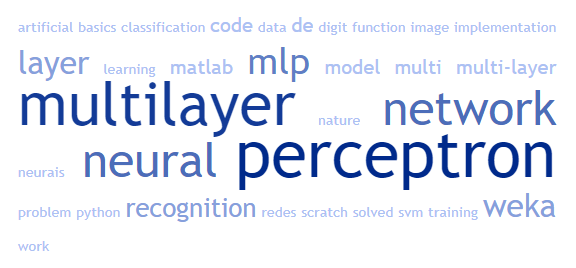
Notes:
A multilayer perceptron (MLP) is a type of artificial neural network that is composed of multiple layers of artificial neurons, or “perceptrons.” It is a supervised learning algorithm, which means that it is trained on a labeled dataset in order to learn a specific task.
MLPs are commonly used for tasks such as classification and regression. In classification tasks, the MLP is trained to predict the class or category of an input based on certain features or characteristics. In regression tasks, the MLP is trained to predict a continuous numerical output based on certain features or characteristics.
MLPs are widely used in a variety of applications, including image recognition, natural language processing, and predictive modeling. They are particularly well-suited for tasks that require learning non-linear relationships between input and output.
Multilayer perceptrons (MLPs) can be used in a variety of ways in dialog systems, which are computer systems that are designed to communicate with humans through natural language dialog.
One way that MLPs can be used in dialog systems is as a classifier to predict the appropriate response to a user’s input. For example, an MLP might be trained on a large dataset of user inputs and corresponding responses in order to learn how to predict the appropriate response to a given input. This could be used in a customer service chatbot, for example, to predict the appropriate response to a user’s question or concern based on the content of the user’s input.
Another way that MLPs can be used in dialog systems is to predict the next action or response in a dialog based on the previous actions or responses. For example, an MLP might be trained on a dataset of dialogs in order to learn how to predict the next action or response in a dialog based on the previous actions or responses. This could be used in a virtual assistant or tutoring system, for example, to predict the appropriate next action or response in a dialog based on the user’s input and the system’s previous responses.
See also:
- Neural Networks (1): Basics
- 10.4: Neural Networks: Multilayer Perceptron Part 1 – The Nature of Code
- Perceptron(single layer) learning with solved Example | Soft computing series
- 10.5: Neural Networks: Multilayer Perceptron Part 2 – The Nature of Code
- Simulating evolution using social bots with multilayer perceptron
- Artificial Neural Networks (Part 2) – -Classification using Multi-Layer Perceptron Model
- Understanding Multi-Layer Perceptron (MLP) .. How it Works
- More Data Mining with Weka (5.2: Multilayer Perceptrons)
- Neural Networks 2 – Multi-Layer Perceptrons
- Multilayer Perceptron | Neural Network in Weka : Weka Tutorials # 5
- Multilayer Neural Network
- Multi layer perceptron on neural network
- But How Does The MultiLayer Perceptron Actually Work?
- Image Recognition – Multilayer Perceptron Neural Network
- 4.3 Multilayer Perceptrons | 4 Neural Networks | Pattern Recognition Class 2012
- Multilayer Perceptron in Python | XOR Gate Problem
- 8 The Backpropagation Algorithm – Multilayer Perceptron (Part I)
- MLP in Weka with Iris data
- Multilayer perceptron coding with MATLAB
- Basics of Neural Networks – Clearly Explained!!! (Perceptrons and Multilayer Perceptrons )
- Multilayer perceptron
- Multi Layer Perceptron
- Solving Two Spirals Problem with Multilayer Perceptron
- [PyTorch] Lab-08-2 Multi Layer Perceptron
- Multiple Layer Perceptron (MLP)
- multilayer perceptron mlp matlab
- Multilayer Perceptron – Build your own neural network in Python from scratch – part 1
- Implementation of Multilayer Perceptron from Scratch
- Multilayer Perceptron
- Multilayer perceptron (MLP) feedforward artificial neural network model
- WEKA – Multilayer Perceptron – 2º Parte
- Fitting a Multilayer Perceptron.
- Neural network – multilayer perceptron on your web browser
- 3D Multilayer Perceptron Demo
- Geometry learning with a multilayer perceptron
- Cellular automata with multilayer perceptron
- Overtraining a Multilayer Perceptron
- Multilayer perceptron
- Bank Note Analysis-(INTRO)Using Logistic Regression, RandomForest, KNN, SVM, Multilayer Perceptron
- Hands-On Neural Network with TensorFlow:Multilayer Perceptron Neural Network|packtpub.com
- Multilayer Perceptron Neural Network
- Extreme overftting in a Multilayer Perceptron.
- Multilayer perceptron training
- Classification Model By Using Multilayer Perceptron, Support Virtual Machine (SVM) and J48 Methods.
- [Sig. Proc.] 2 Layers 3D Gaussian Function Approximation Multilayer Perceptron MLP Networks
- image (digits) recognition multilayer perceptron Octave or matlab
- information transfer multilayer perceptron over training
- Long-Term Forecasting the Survival in Liver Transplantation Using Multilayer Perceptron Networks
- Multilayer Perceptron Preprocessing
- Vídeo Multilayer perceptron
- Implementation of Schaffer Function using Multilayer Perceptron
- Weka result with Multilayer perceptron – 81% accuracy
- Digit Recognition Menggunakan Multilayer Perceptron
- Redes Neurais: Funções de ativação para o MultiLayer Perceptron (MLP)
- Redes Neurais: Explicação de Exercício de Propagação em MultiLayer Perceptron (MLP)